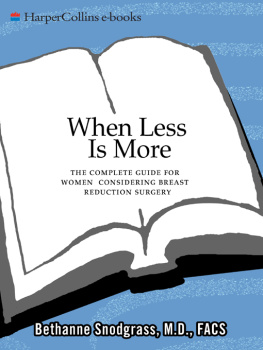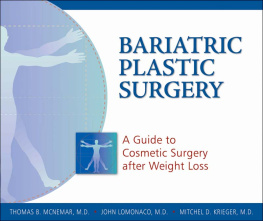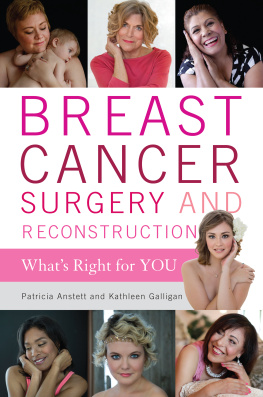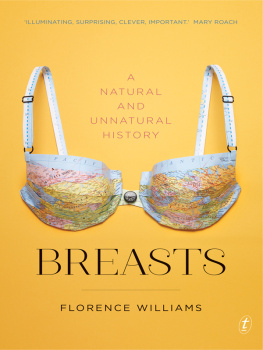WHEN Less IS MORE
THE COMPLETE GUIDE FOR
WOMEN CONSIDERING
BREAST REDUCTION SURGERY
BETHANNE SNODGRASS, M.D., FACS

T o Marianna,
my Sweet Pea
Contents
T his book has been a labor of love, but it could not have been written without the immeasurable help of so many talented and patient people. I extend my sincerest thanks to the following people for their invaluable contributions: Kris Beard, Wally Chang, Roy Schneider, Art Squires, Jim Stengle, and Hal White. Thanks also go to Bill Ahern, Gary Geiger, Debbie Ibarra, Joanie Koester, Steve Mayo, Jinger Rawski, Delaine Schmitz, Gina Smith, Kelly Kennelly, the pharmacy staff at Flower Hospital, and to Elizabeth Lyon, whose superb book on how to write a successful nonfiction book proposal fulfilled its promise.
I owe a special debt of gratitude to my literary agent, Barbara Lowenstein, for making this book a reality and to the staff at HarperCollins, most particulary my wonderful editor, Nick Darrell, for so gently but firmly keeping me on the straight and narrow path.
Finally, I am eternally indebted to my family and friends for their unfailing support and encouragement, especially Dolli Darah, Nita Ellis, Monica Malhoit, and Sandy and Louise Mattingly; Mimi, Ari, and Roger; my father, Roger Snodgrass, for being my toughest and most relentless editor; my mother, Mary Ann Snodgrass, for her efforts to teach me the rules of style; my brother-in-law, Steven Peikin, for paving the way and challenging me to follow; and last but not least my sister, Lori Snodgrass Peikin, for far too many things to list, including having the extraordinary good taste to marry Steve.
P erhaps no other part of the human body is more synonymous with femininity than the breasts. The social significance attributed to breasts is only reinforced and perpetuated by the media and popular culture. Many times breasts have great significance to a womans spouse or partner, which places another layer of concern for the woman considering breast reduction surgery and often contributes to her fear and confusion.
Although the medical literature and the Internet are replete with information on the subject, information written for and aimed at the lay audience is almost nonexistent. When Less Is More finally bridges this gap. Dr. Snodgrass skillfully dissects the subject of breast reduction and places each component into logical, stepwise, and detailed chapters, keeping the uninitiated in mind. Her language and style are clear and easy to read. Scarcity of professional jargon and medical terminology coupled with clearly illustrated line drawings present each topic in a concise and easily understood format.
In addition, Dr. Snodgrass uniquely includes explanations of the causes and evolution of symptoms associated with mammary hypertrophy, as well as conservative measures to alleviate those symptoms through stretching and exercises.
Dr. Snodgrass includes many details that are often overlooked at the initial consultation and/or during hurried postoperative instructions. Yet all of these details share a common goal: to have a thoroughly informed patient who has been given the tools to make well considered choices and who will face surgery with confidence.
When Less Is More is a must-read for all women considering or facing breast reduciton surgery. Those dealing with this issue owe Dr. Snodgrass a debt of gratitude, for she has eased their way.
Wallace H. J. Chang, M.D.
Professor of Plastic Surgery
Division of Plastic Surgery
University of Washington School of Medicine
Seattle
February 2005
T his book is about breast reduction, or reduction mammaplasty, which is surgery to make breasts smaller. If you have ever thought your breasts were too big, this book was written for you. You may be a teenager wearing a baggy shirt to hide your breast size, or you may be a grandmother with deep grooves in your shoulders from your bra straps. You may be a corporate executive, a stay-at-home mom, or you may work two jobs to make ends meet. What you all have in common is that you want to look and feel better. Many of you are dealing with body weight issues, but despite dieting your breast size does not decrease. You want to get relief from your back pain and headaches, you want to be able to buy clothes that fit, and yes, you want to look more attractive. Finally, each of you wants answers to these questions:
- Will a breast reduction really help me?
- Do I have any options besides surgery to help me feel better?
- How do I find a good surgeon?
- Will my insurance pay for the surgery?
- Is the surgery risky?
- If I decide to have surgery, how long will it take for me to be healed and back to my normal routine?
- Is now a good time in my life to have breast reduction surgery?
Whether you are a woman of color concerned about scarring or a busy mom wondering if you will be able to manage your household after surgery, this book will help you. I encourage you to read the entire book before you decide whether you want to have surgery. Then, when you meet your surgeon for the first time, you will already be a well-informed patient. You will get more out of your conversations with your surgeon and, most important, you will feel more confident. You also will find the answers to virtually all of your postoperative questions as you recover and begin to develop your new body image. It is my belief that breast reduction is one of the most effective surgeries available to improve the quality of life for many women, and this book was written to give you the essential information you need before and after surgery.
Twenty years ago I was a plastic surgery resident learning to do the kinds of surgery for which plastic surgeons are famousface-lifts, rhino-plasties (nose jobs), breast augmentations (enlargement with implants)operations that fall into the category of cosmetic, or aesthetic, surgery. The purpose of these operations is to improve the appearance of normal body areas. As a resident I took care of many cosmetic surgery patients as well as hundreds of patients undergoing complex reconstructive procedures to correct deformed, diseased, or injured parts of the body. What really impressed me was a group of patients who fit into both the cosmetic and reconstructive categoriesthe breast reduction patients. They were some of the happiest patients I had seen.
Plastic surgeons have a wonderful specialty: We are able to help bring happiness to the lives of many people. However, I cannot think of another operation where patients get so much immediate relief as women do after breast reduction. Yes, there are incisions to heal, and yes, reduced breasts take time to resume a natural shape. But this is what I tell my friends who wonder why a woman would want smaller breasts: Imagine living with a sack of flour hanging on a chain around your neck, thinking you will have to wear that load twenty-four hours a day for the rest of your life. Then imagine suddenly realizing that there is a way that you can take the load off and never have to wear it again. Who cannot sense the enormous relief that removing that weight would bring?
Why did I write this book? The simple reason is that more and more women are having breast reduction surgery every year, and there are no books available on the subject for the lay reader. If you have been thinking about breast reduction for a while, you know that before this book was published there was very little information readily available for potential patients. Recently the mass media have been paying more attention to breast reduction, since celebrities such as Queen Latifah, Drew Barrymore, Christina Ricci, Soleil Moon Frye, Mary J. Blige, Roseanne Barr, Patricia Heaton, Loni Anderson, Phyllis Diller, and Nancy Sinatra have all talked about having had breast reduction surgery. Reality television shows such as Extreme Makeover have portrayed ordinary people having plastic surgery, including breast reduction. But unless you happen to watch one of the more educational programs featuring breast reduction, you are unlikely to learn very much about the surgery from popular magazines and television. Many women seek information on the Internet because there has been nowhere else to turn. (I always caution patients about the Internet: It is easy to be unnerved by biased and unbalanced comments. Stick with reputable institutional Web sites and avoid chat rooms and other sites where you dont know the source of their information.) For example, the American Society of Plastic Surgeons Web site has a good summary about breast reduction, and the FDA Web site has a short article on the subject. But comprehensive information in one resource has not been available anywhere, until now.









